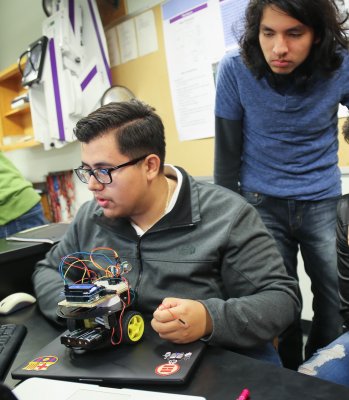GC students’ app will deliver digital walking tour of Goshen’s historical landmarks

Three Goshen College students are using their knowledge of computer science to bring new, innovative technology to share the history of Goshen, Indiana.
Esteban Montoya of Goshen, Patryk Ostrowski of Jezow Sudecki, Poland, and Mikol Aspinwall of Goshen, all GC seniors and computer science majors, have spent the past few months working on a virtual walking tour for the Goshen Historical Society.
As of right now, the Goshen Historical Society has self-guided walking tours featuring many different historic areas of Goshen — the Elkhart County Courthouse, the Jefferson Theater and the police booth, to name a few. Brochures and pamphlets full of information lead tourists and history buffs all around town with photos, text and a map.
But now, Montoya, Ostrowski and Aspinwall are working towards creating an app that will allow users to drop by notable points in Goshen and instantly receive information on their phones about the historic site via “beacons” — or signs — equipped with wireless near field communication (NFC) tags.
John Hertzler, a board member and volunteer at the historical society, said that the project is a way to engage people of all ages with the history of Goshen.
“My thought was that we should make the walking tours more interactive — but [the volunteers at the historical society] don’t know how to do that,” said Hertzler, a 1958 Goshen College alumnus. “That’s where the young upstarts come in.”
The project idea comes from Hertzler and Jeanette Shown, associate professor of computer science and information technology. The two longtime friends discussed ways to update the historical society while involving GC students.
Making a user-friendly product
One of the most important features of the app is that it is easy to manage, as Goshen Historical Society volunteers need to be able to insert and add information about the historical sites. According to Aspinwall, sustainability is high on the group’s list of priorities.
“Every piece of our development process is built around the users,” Aspinwall said. “We know the users are probably not as technologically fluent as we computer science majors are, so we’re working to make sure everything is pretty user-friendly.”
Aspinwall said he appreciated helping the Goshen Historical Society update to match the technological age.
“One of the key parts I’ll take away from this is the ability to create a solution that will be deployed into the real world and needs to hold its own for a long time,” Aspinwall said. “That’s the part I hope to do again.”
Prototype phase
The project is currently in its “prototype phase,” according to Aspinwall. Each student is working on a different aspect of the project: Montoya leads the group and handles most communication between the students and Hertzler; Aspinwall works with the hardware of the NFC tags; Ostrowski works on programming the app. The students are working as interns and receiving college credit for the project.
They plan to finish the project by April or May of 2019 — just about the same time the three computer science majors will be receiving their diplomas and heading into the working world.




